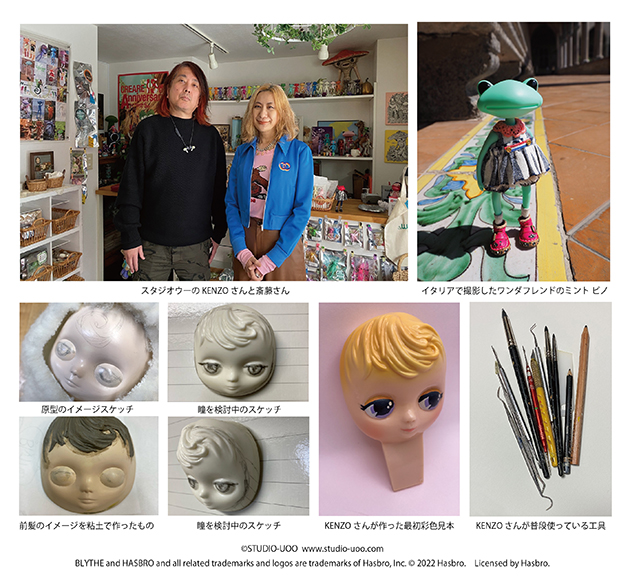
CWC (Isaac): Thank you so much for agreeing to be interviewed today, Saito-san and KENZO-san. To the readers, as Studio Uoo, they were in charge of prototyping Luv Hug's face and helping facilitate the production. We couldn't have gotten such a lovely result without them. I'd like to ask them about the production process and the future.
CWC: In the beginning, when we contacted you two about Luv Hug, what were your first reactions?
Saito: It's a new series from Blythe, so I felt very honored. I've been a fan of Blythe since I was the editor-in-chief of Bean's magazine. I'm happy to be a part of it! With that in mind, I tried my best to do what I could, but on the other hand, I wasn't sure how much I could help since the style and personality of Wonder Frog are very different from Blythe's. But since you trusted us and offered us the job, we decided to do our best.
CWC: I'm glad that there was a determination to make it great through the anxiousness of working on this project. Personally, I was impressed when KENZO-san made the hair sculpt on the spot in an online meeting. How was the process of making the faceplate for you, KENZO-san?
KENZO: When I began, I proceeded with the production based on the atmosphere of the concept illustration I received from CWC and the premise of creating a new face that inherited the cuteness of Blythe. In a way, I didn't have any doubts, but I thought I'd have to leave it up to everyone to decide if the finished product was "cute" or not.
Saito: When I check the face sculpt, the expression looks different depending on the angle of view. Unlike dolls with three-dimensional insert eyes, KENZO had to create expressions under limited conditions. In that sense, I think Kenzo was able to bring the best of his style to the table. The face is based on a Middie Blythe, but it wasn't just a matter of making her the same. The challenge was about how far we could go to express the cuteness of Midi and create that feeling.
KENZO: Creating an aura or feeling is essential. Just shaping a similar face in an inorganic way won't make it cute, and there was a request at the meeting to create a retro or romantic feel, so I thought a lot about it. There were several retakes on the angle of the cheeks and the lips. We went through a lot of trial and error, repeatedly adding or removing just a thin layer of thickness to make it look cute from any angle.
Saito: Even a slight change in the angle of the eyes can give a completely different impression, can't it? I had a lot of discussions with Isaac about whether we should make the eyes a little down or add another highlight. It was challenging!
CWC: Yes, it was... You could change the impression of the face entirely with just a millimeter here or there. I drew sketches of the face many times, but it still wasn't hitting the same impression in 3D. For Neo Blythe, I can change the expression by changing the direction of the eyes; for Love Hug, however, the expression changes by the angle of view. Applying the pupil design on the 3D face was interesting and challenging because mistakes will float up to the surface almost immediately.
Saito: Wasn't there also the difficulty of creating the design? Even if the pupil drawings on a flat surface were cute, the shape would change depending on the angle if you drew it in three dimensions.
KENZO: Yes, you can draw as well as you want digitally, so when you look at it, you may fall into the illusion that it's finished. If the finished illustration is well done, the person who drew it thinks the final result will be like that. But it doesn't turn out that way when you actually make it three-dimensional.
CWC: It's a bit of an interplay between the imagined result and the actual process. The final sketch is quite different from the real thing. Many things can be done on paper but, in turn, can't be done in 3D.
KENZO: I was afraid that the design drawing would be different from the original shape of Blythe's eyes. In the end, we respected the form of Blythe's eyes as much as possible. We applied Isaac's sketches on top of it to get the best possible result.
CWC: What kind of colorway would you like to see in the future?
KENZO: Well, I think it would be interesting to listen to the users as much as possible and decide on a new design. There are many products, such as toys, where the manufacturer sends out the idea, and the user just accepts it. I think it's a good idea to take the users' opinions and turn them into reality.
CWC: It sounds interesting because the stencils for the faces are already set, so it's easy to do.
KENZO: Yes, it would be good to give out images for coloring faces and receive feedback. The feeling of being nurtured by the user is a little different from that of just a stuffed animal. I think this can also be done because it's drawn.
CWC: What is the most important thing for you as an artist, KENZO? What do you pay attention to in terms of what you think is "interesting" and what your customers want?
KENZO: At Studio Uoo, we make "products" rather than "artworks," so it's important to me to pay attention to certain things. There are three things that I do:
1. I make my work the way I want to, based on the stories that come to me from my imagination.
2. Create something that I want to sell as a company product.
3. Make something that can be marketed properly.
When I think of a new product, there are many hurdles to overcome, and I often wonder if I can clear them.
CWC: If you think of it as one step at a time, do you start with the impulse to create a character, and then from that list of things you want to create, you create something that has the certainty to make it work as a business?
KENZO: It's a combination of that. If I decide that I can't rank the work I've made in the future, or if it's made but doesn't tell a good story, or if I can't make the most of it, I may discard it. First of all, I have to get over the hurdle I have in my mind. Then I have to have the final judgment within the company. Only after it's ready to be sold does it travel to the factory. Hence, it's a long process (laughs).
CWC: Is there a time when you enjoy creating the most?
KENZO: Hmmm... After it's finished.
CWC: After it's finished!
KENZO: It's a demanding process to be thinking or creating... Despite how often I hear people say that working in a toy store must be pleasant.
CWC: (laughs)
KENZO: Sometimes, I even get angry at myself for letting my imagination get the better of me.
CWC: (laughs)
KENZO: If it comes to me, I have no choice but to make it... I sometimes wonder what I'm making and why I'm making it. Once it's done, I can see the quality, and I start thinking, "This is lame," or "This needs to be done better. And because it's a sedentary job, I still have my strength, but I drain my mental energy daily. So I'm relieved when it's done. It's the most fun when people respond well to it or when it sells well.
CWC: I can relate to that (laughs). I'm fortunate that you guys and Naito Design, the plush manufacturer, are very kind to me. I haven't felt that pain yet, but I know that the pressure of making something and selling it is very hard.
KENZO: Rather than trying to sell out everything in a short period, I think it's better to take care of the fans who gather over a long time. First of all, I think it's essential to take care of the users who come to enjoy the product one by one.
CWC: What do you think is the most crucial thing that forms the foundation of a toy?
KENZO: I think it's something surprisingly simple. Something that makes you not want to let go of the toy the moment you hold it in your hand, something that immediately makes you happy just by having it. It could be a block or a tub of slime. I think that's what's fundamentally important, the sense of making people happy.
Saito: It's a primal feeling, isn't it?
KENZO: Yes, like when a child only holds the same toy until it's ragged. I think that's what's important at the core, the thing that makes toys feel fun, cute, and irreplaceable. There are times when the creator assumes what's best for the customer, creating something that covers all of the bases that don't hit or stick. I think it's better to bring out the direct appeal that things have instead of overthinking it.
Saito: I think it's important for toys to have a story. Not necessarily about the story content a toy has, but for example, vintage and historical items also have a story about the time and era it has lived through, don't they? I think that's fascinating. I feel that from Blythe, too. It doesn't matter if the details are simple or complex; conveying them is what is essential. I think it's like a life that the creator breathed into it. Some toys are made with high-quality materials and artisanship but don't attract me. Some are simple and poorly made, but somehow I find them cute. I think there is something invisible about them. (laughs) As if I can feel the hand of the creator. So when I see the toys fallen on the floor in strange poses, I can't help but think, "Oh no, you poor thing!" (laughs).
CWC: You become emotionally involved with them.
Saito: Yeah, when I drop a toy, I think, "I'm sorry!" but if I drop a pair of scissors, I don't necessarily feel that emotion. I think that's the difference.
KENZO: That's what we value at Studio Uoo.
CWC: While working on Luv Hug, I also felt that the more I designed the face and body parts, the more the character's humanity and personality grew. Of course, the fact that Blythe's face is compelling has something to do with it, but I felt that the combination of the soft vinyl and the cloth gave it a soul. Like the way they sit...
Saito: Yes, when a single, adorable being is born... It's like giving birth to a child, although Isaac is a man (laughs).
CWC: No, but I did feel the pain! It's like psychological pain. (laughs) To make something, you have to pay for something. You have to pay for something to make something, but making something is also fun. Speaking of which, what do you enjoy making the most at Studio Uoo? Motifs, for example?
Saito: Studio Uoo is already a frontier, and we started out with the idea of doing things freely, whether it's toys or books, so it's fun to challenge ourselves freely. Wanda is our most important content, but we want to expand the world further. I'd be happy if more people could get to know Wanda. I'd also like to do something with spherical joints and a slightly different atmosphere from Wanda.
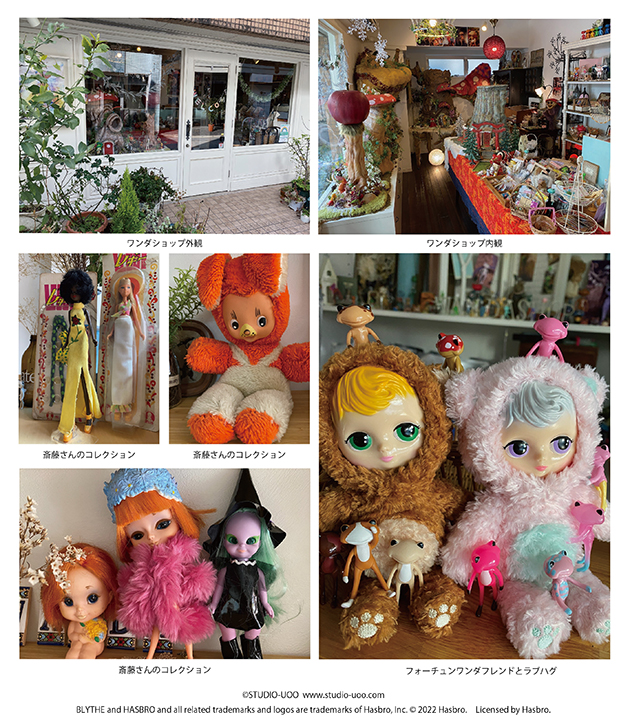
CWC (Isaac): Thank you so much for agreeing to be interviewed today, Saito-san and KENZO-san. To the readers, as Studio Uoo, they were in charge of prototyping Luv Hug's face and helping facilitate the production. We couldn't have gotten such a lovely result without them. I'd like to ask them about the production process and the future.
CWC: In the beginning, when we contacted you two about Luv Hug, what were your first reactions?
Saito: It's a new series from Blythe, so I felt very honored. I've been a fan of Blythe since I was the editor-in-chief of Bean's magazine. I'm happy to be a part of it! With that in mind, I tried my best to do what I could, but on the other hand, I wasn't sure how much I could help since the style and personality of Wonder Frog are very different from Blythe's. But since you trusted us and offered us the job, we decided to do our best.
CWC: I'm glad that there was a determination to make it great through the anxiousness of working on this project. Personally, I was impressed when KENZO-san made the hair sculpt on the spot in an online meeting. How was the process of making the faceplate for you, KENZO-san?
KENZO: When I began, I proceeded with the production based on the atmosphere of the concept illustration I received from CWC and the premise of creating a new face that inherited the cuteness of Blythe. In a way, I didn't have any doubts, but I thought I'd have to leave it up to everyone to decide if the finished product was "cute" or not.
Saito: When I check the face sculpt, the expression looks different depending on the angle of view. Unlike dolls with three-dimensional insert eyes, KENZO had to create expressions under limited conditions. In that sense, I think Kenzo was able to bring the best of his style to the table. The face is based on a Middie Blythe, but it wasn't just a matter of making her the same. The challenge was about how far we could go to express the cuteness of Midi and create that feeling.
KENZO: Creating an aura or feeling is essential. Just shaping a similar face in an inorganic way won't make it cute, and there was a request at the meeting to create a retro or romantic feel, so I thought a lot about it. There were several retakes on the angle of the cheeks and the lips. We went through a lot of trial and error, repeatedly adding or removing just a thin layer of thickness to make it look cute from any angle.
Saito: Even a slight change in the angle of the eyes can give a completely different impression, can't it? I had a lot of discussions with Isaac about whether we should make the eyes a little down or add another highlight. It was challenging!
CWC: Yes, it was... You could change the impression of the face entirely with just a millimeter here or there. I drew sketches of the face many times, but it still wasn't hitting the same impression in 3D. For Neo Blythe, I can change the expression by changing the direction of the eyes; for Love Hug, however, the expression changes by the angle of view. Applying the pupil design on the 3D face was interesting and challenging because mistakes will float up to the surface almost immediately.
Saito: Wasn't there also the difficulty of creating the design? Even if the pupil drawings on a flat surface were cute, the shape would change depending on the angle if you drew it in three dimensions.
KENZO: Yes, you can draw as well as you want digitally, so when you look at it, you may fall into the illusion that it's finished. If the finished illustration is well done, the person who drew it thinks the final result will be like that. But it doesn't turn out that way when you actually make it three-dimensional.
CWC: It's a bit of an interplay between the imagined result and the actual process. The final sketch is quite different from the real thing. Many things can be done on paper but, in turn, can't be done in 3D.
KENZO: I was afraid that the design drawing would be different from the original shape of Blythe's eyes. In the end, we respected the form of Blythe's eyes as much as possible. We applied Isaac's sketches on top of it to get the best possible result.
CWC: What kind of colorway would you like to see in the future?
KENZO: Well, I think it would be interesting to listen to the users as much as possible and decide on a new design. There are many products, such as toys, where the manufacturer sends out the idea, and the user just accepts it. I think it's a good idea to take the users' opinions and turn them into reality.
CWC: It sounds interesting because the stencils for the faces are already set, so it's easy to do.
KENZO: Yes, it would be good to give out images for coloring faces and receive feedback. The feeling of being nurtured by the user is a little different from that of just a stuffed animal. I think this can also be done because it's drawn.
CWC: What is the most important thing for you as an artist, KENZO? What do you pay attention to in terms of what you think is "interesting" and what your customers want?
KENZO: At Studio Uoo, we make "products" rather than "artworks," so it's important to me to pay attention to certain things. There are three things that I do:
1. I make my work the way I want to, based on the stories that come to me from my imagination.
2. Create something that I want to sell as a company product.
3. Make something that can be marketed properly.
When I think of a new product, there are many hurdles to overcome, and I often wonder if I can clear them.
CWC: If you think of it as one step at a time, do you start with the impulse to create a character, and then from that list of things you want to create, you create something that has the certainty to make it work as a business?
KENZO: It's a combination of that. If I decide that I can't rank the work I've made in the future, or if it's made but doesn't tell a good story, or if I can't make the most of it, I may discard it. First of all, I have to get over the hurdle I have in my mind. Then I have to have the final judgment within the company. Only after it's ready to be sold does it travel to the factory. Hence, it's a long process (laughs).
CWC: Is there a time when you enjoy creating the most?
KENZO: Hmmm... After it's finished.
CWC: After it's finished!
KENZO: It's a demanding process to be thinking or creating... Despite how often I hear people say that working in a toy store must be pleasant.
CWC: (laughs)
KENZO: Sometimes, I even get angry at myself for letting my imagination get the better of me.
CWC: (laughs)
KENZO: If it comes to me, I have no choice but to make it... I sometimes wonder what I'm making and why I'm making it. Once it's done, I can see the quality, and I start thinking, "This is lame," or "This needs to be done better. And because it's a sedentary job, I still have my strength, but I drain my mental energy daily. So I'm relieved when it's done. It's the most fun when people respond well to it or when it sells well.
CWC: I can relate to that (laughs). I'm fortunate that you guys and Naito Design, the plush manufacturer, are very kind to me. I haven't felt that pain yet, but I know that the pressure of making something and selling it is very hard.
KENZO: Rather than trying to sell out everything in a short period, I think it's better to take care of the fans who gather over a long time. First of all, I think it's essential to take care of the users who come to enjoy the product one by one.
CWC: What do you think is the most crucial thing that forms the foundation of a toy?
KENZO: I think it's something surprisingly simple. Something that makes you not want to let go of the toy the moment you hold it in your hand, something that immediately makes you happy just by having it. It could be a block or a tub of slime. I think that's what's fundamentally important, the sense of making people happy.
Saito: It's a primal feeling, isn't it?
KENZO: Yes, like when a child only holds the same toy until it's ragged. I think that's what's important at the core, the thing that makes toys feel fun, cute, and irreplaceable. There are times when the creator assumes what's best for the customer, creating something that covers all of the bases that don't hit or stick. I think it's better to bring out the direct appeal that things have instead of overthinking it.
Saito: I think it's important for toys to have a story. Not necessarily about the story content a toy has, but for example, vintage and historical items also have a story about the time and era it has lived through, don't they? I think that's fascinating. I feel that from Blythe, too. It doesn't matter if the details are simple or complex; conveying them is what is essential. I think it's like a life that the creator breathed into it. Some toys are made with high-quality materials and artisanship but don't attract me. Some are simple and poorly made, but somehow I find them cute. I think there is something invisible about them. (laughs) As if I can feel the hand of the creator. So when I see the toys fallen on the floor in strange poses, I can't help but think, "Oh no, you poor thing!" (laughs).
CWC: You become emotionally involved with them.
Saito: Yeah, when I drop a toy, I think, "I'm sorry!" but if I drop a pair of scissors, I don't necessarily feel that emotion. I think that's the difference.
KENZO: That's what we value at Studio Uoo.
CWC: While working on Luv Hug, I also felt that the more I designed the face and body parts, the more the character's humanity and personality grew. Of course, the fact that Blythe's face is compelling has something to do with it, but I felt that the combination of the soft vinyl and the cloth gave it a soul. Like the way they sit...
Saito: Yes, when a single, adorable being is born... It's like giving birth to a child, although Isaac is a man (laughs).
CWC: No, but I did feel the pain! It's like psychological pain. (laughs) To make something, you have to pay for something. You have to pay for something to make something, but making something is also fun. Speaking of which, what do you enjoy making the most at Studio Uoo? Motifs, for example?
Saito: Studio Uoo is already a frontier, and we started out with the idea of doing things freely, whether it's toys or books, so it's fun to challenge ourselves freely. Wanda is our most important content, but we want to expand the world further. I'd be happy if more people could get to know Wanda. I'd also like to do something with spherical joints and a slightly different atmosphere from Wanda.
CWC: Have you been doing any collecting lately?
Saito: I've been a collector since I was born (laughs). I like American and Japanese dress-up dolls from the 60s and 70s a lot, and they satisfy my own fashion taste. It's nice to be able to let my creativity run wild and play with styling... I also like unique things. Loco-tan, Kamar dolls, or a witch doll with shiny eyes called Emerald Witch or Ashinaga Leggy.
CWC: Her legs are so long!!
Saito: There are toys of many different races in the United States, which is so cool.
CWC: Besides Blythe, did you use any other vintage dolls as reference for the face of Love Hug?
Saito: Well, the doll that came to mind was a stuffed animal with a plastic face from the East German era. They have a rustic charm to them.
CWC: Oh! She's so cute!
KENZO: When I heard about Luv Hug, this one was the first doll that came to mind. It's a hugging doll, so the neck is kind of tattered, so I put a neck plate on the Luv Hug to give it support.
CWC: That makes sense. It's also interesting that she's a little bald. (laughs) I can sense that the designer has a lot of talent by looking at the face.
Saito: There are so many interesting designs from Europe in the past. The symbols we are familiar with haven't been established yet.
CWC: Do you have any favorite toys that fall into the category of plush toys?
Saito: Well, Steiff is very famous. But recently, I also like the unique ones made by individual artists. I feel a warmth in handmade dolls, and sometimes there are some crazy ones (laughs). I like stuffed animals with unusual motifs. I also like the simple stuffed animals sold at zoos.
CWC: Oh! That was a blind spot. There are some pretty good ones, aren't there?
Saito: They don't over-extend themselves; they're just representations of animals to give to a child. There's a purity to them, and that's what makes it cute.
CWC: It's not dressed up.
Saito: That's right. There was an exhibition held last year that visualized the vision of Alessandro Michele, the creative director of Gucci. They filled an exhibit with non-branded stuffed animals made for the zoo. It made me wonder if artists feel newness and "love" in such mundane things.
CWC: Yes, the more ordinary something is, the closer it is to humanity and the more it can be incorporated into art.
Saito: It's like an approachable sense of distance. Stuffed animals are made to be hugged. It’s like they represent an aspect of humanity.
CWC: Lastly, is there a character in Wanda's story that you're most excited about?
KENZO: I'd have to say all of them.
Saito: A good father. (laughs) They're all like our children, but I'd have to say Wanda, the main character (laughs).
CWC: (laughs). Thank you very much.
Profile
Ayumi Saito
President of Studio Uoo Ltd. After making her debut as a manga artist in Shogakukan's Weekly Shonen Sunday magazine, she switched careers from manga artist to editor. She has worked as an editor for many magazines and books, including game and anime magazines. After that, he launched Studio Uoo and planned and produced the toy magazine Bean's (Sony Magazines). Significant works include AKIRADVDSpecialEdition (Bandai), Katsuhiro Otomo POSTERS (Pie Books), MEDICOMTOY20thAnniversary1996-2016 (Medicom Toy), Petit Mania Petit Blythe Complete Catalog (1)(2) (Sony Magazines), etc. (Sony Magazines), etc. She is currently the producer and director of WonderFrog and the manager of the Wanda Shop.
KENZO
Kenzo is a sculptor and artist. After establishing his own studio, he has done special effects work for TV, movies, and games. Some notable projects include Kamen Rider and Keita Amemiya's works. He later joined Studio Uoo developing the world of WonderFrog based on his own original work. He is in charge of the story, prototype production, design, and graphic design entirely. He is also the face sculptor for Luv Hug Blythe.


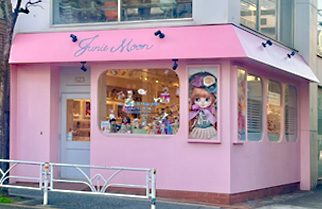 Tokyo
Tokyo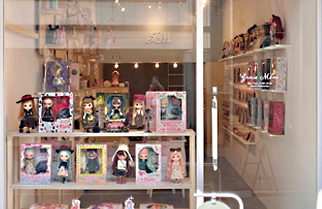 Osaka
Osaka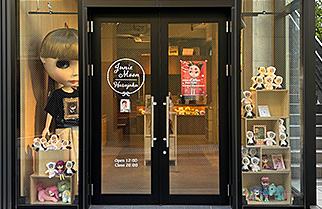 Tokyo
Tokyo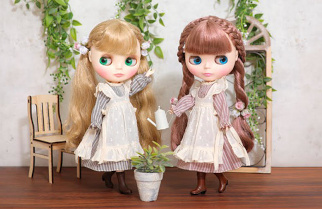 Doll Fashion
Doll Fashion Junie Moon
Junie Moon